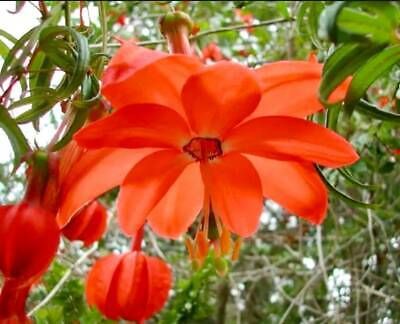Your Plant Bitch
Variety of Passiflora Seeds ~ Passionflower ~ Maypop ~ Passion Fruit Flower ~
Variety of Passiflora Seeds ~ Passionflower ~ Maypop ~ Passion Fruit Flower ~
Couldn't load pickup availability
The fruit is a pepo, a type of berry, round to oval, either yellow or dark purple at maturity, with a soft to firm, juicy interior filled with numerous seeds. The fruit is both eaten and juiced, with the juice often added to other fruit juices to enhance aroma.
~ Includes ~
~ 20 Seeds of Your Plant Bitch’s Passionflower Mix (may include) :
Supersect (banana passionflower).
Passiflora Caerulea (blue passionflower).
Passiflora Coccinea (red passionflower).
Passiflora Cncarnata (purple passionflower).
Passiflora Alata 'Ruby Glow' (fragrant granadilla).
~ Grow and Care Instructions.
✨ Follow Me ✨
Instagram: YourPlantBitch
Facebook: Your Plant Biitch
💕 Please visit YourPlantBitch to explore all of my new and exclusive collections. Rest assured, my main concern is my customers always!!! I try to provide the best customer service and strive to create a positive shopping experience for my customers. I’m always available to answer any questions or concerns you may have before and after your purchase. Custom orders are welcome!!! I can even include a handwritten gift card for no additional cost. Feel free to send me an offer, I will always do my absolute best to work with my customer’s offers. Contact me with any questions or if you’re interested in my sold~out items or need different quantities.
💞Awesome reviews are truly ALWAYS appreciated!!! Thank you so very much for supporting my small business!!!
💜 Passionflower Grow and Care Instructions 💜
Passionflower grows best outdoors, but if you live in an area with freezing winters in a USDA zone lower than a mild 6, bring your passionflower vine indoors as the threat of frost approaches. Grow it in a south-facing room, sunroom, or greenhouse. When grown inside, it will not grow as vigorously nor produce fruits.
Dig up your passionflower with its rootball intact and repot it in a container with ample drainage holes in moistened, enriched potting soil. If possible, move your plant back outdoors in the spring once the threat of frost is over.
Light
To keep your passionflower vines healthy and blooming, plant them in full sun to partial shade. Plants appreciate some afternoon shade in extremely hot climates. Passionflowers generally need at least four to six full hours of sunlight a day (or more in cooler climates). If you bring potted specimens indoors for the winter, give them bright, indirect light and keep them away from drafts.
Planting and Soil
The soil in which you plant your vines should be well-draining but rich and moist. Soil pH isn't important and can be in the neutral to the acidic range, anywhere from about 6.1 to 7.5. Adding compost to the planting hole will help provide nutrients, and mulching around the plant's base will assist in retaining moisture without having the plant become waterlogged.
Passionflower is best planted in the spring or fall. It prefers a sheltered area, like a wall. Typically, some support is needed for passionflower vines to grow, such as a trellis, a structure, or another plant. You can train it to go up a pergola or other structure, but it only needs a little guidance and doesn't require tying since it has self-clinging tendrils.
Water
Passionflowers should be given a deep watering immediately after planting. Beyond that, they typically thrive with one or two waterings per week throughout their growing season. Make sure to provide about 1 inch to 1.5 inches of water every week.
Temperature and Humidity
Passionflower plants love warm weather and may need winter protection in cooler regions. To prevent your plant from dieback, bring it indoors as temperatures drop. Plant them in an area that's protected from wind, as a strong wind can damage stems and burn leaves. In addition, they do best in areas with moderate to high humidity.
Fertilizer
Passionflower vines are heavy feeders and will benefit from a regular light application of balanced, general-purpose fertilizer with equal proportions of nitrogen, phosphorus, and potassium. Fertilize the plant before new growth emerges in early spring, and then repeat every four to six weeks until early autumn.
🪴Happy Planting🪴
💚 Best Wishes, Your Plant Bitch (Quinn)
Share




















